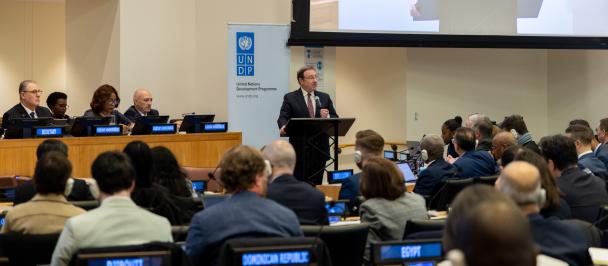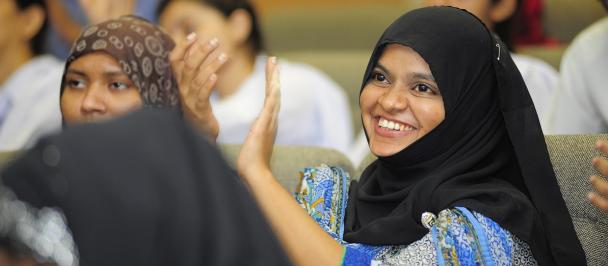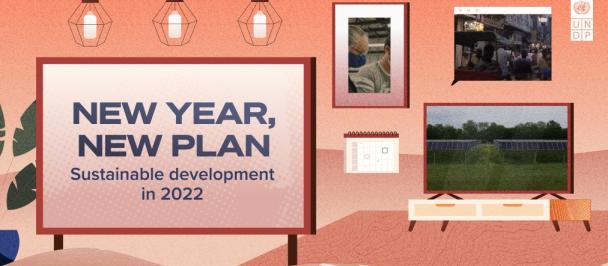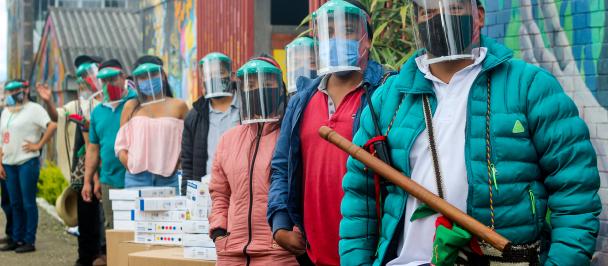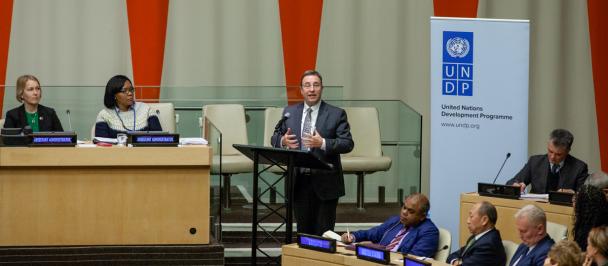Preparing the ground for a 22nd Century where every person has equal opportunities and freedoms, and the inequalities we see today are a thing of the past
Launch of 2019 Human Development Report
December 9, 2019
As prepared for delivery.
Opening
Your Excellency, President Duque,
President Chinchilla,
Distinguished Guests,
Ladies and gentlemen,
I am delighted to launch the United Nations Development Programme’s (UNDP) flagship Human Development Report here in Colombia -- a country that has made great progress over the past number of decades.
This is borne out by its rank on the Human Development Index, which has risen from 95 to 79.
Between 1990 and 2018, for example, Colombia’s life expectancy at birth increased by more than seven years, while the average years of schooling increased by nearly three years.
I know that UNDP here in Colombia is working closely with your Government, the private sector and civil society, Mr. President, on issues ranging from sustainable value chains and inclusive markets, advancing stabilization and fighting climate change to generating new and better data to help those at risk of being left behind, which I understand is a focus of the UNDP Accelerator Lab we launched together this year.
UNDP looks forward to continuing our partnership with Colombia today, and into the future, including as we unpack the analysis of this new Human Development Report on inequality.
Mr. President, ladies and gentlemen.
When the Human Development Report first appeared in 1990, it captured the attention of the global community because it offered a different way – beyond income -- of seeing the world and measuring its progress.
Almost 30 years since its inception, the HDR and its Human Development Index, which ranks all countries in the world by their level of human development, remains a powerful voice.
This year’s report is the first of a new generation of HDRs for UNDP, pushing the boundaries as part of #NextGenUNDP to accelerate thought leadership, drive conversation on the future of development, and in so doing, advance progress towards the 17 Sustainable Development Goals.
We are delighted to be in excellent company as we embark on a new generation of HDRs. This year, that company included Mr. Thomas Piketty and his team at the World Inequality Lab at the Paris School of Economics, represented here today by Mr. Lucas Chancel, and a series of eminent international figures including the former President of Costa Rica, Laura Chinchilla.
In addition to thanking our kind hosts, I know I join with my colleagues Pedro, Luis Felipe and Jessica when I say thank you so much, Madam President and Mr. Chancel, both for taking the time to be with us today and for your deep investment in this HDR over the past year.
The topic of the HDR this year is a pertinent one. It sets out that despite unprecedented progress against poverty, hunger and disease, systemic inequalities are deeply damaging our society, and it analyses why.
Inequality is not just about how much someone earns compared to their neighbour. It is about the unequal distribution of wealth and power, the entrenched social and political norms that are bringing people onto the streets in cities and towns across the world, and the triggers that will do so in the future unless something changes.
Indeed, the abilities people will need to compete in the immediate future have evolved. Assets like tertiary education and access to broadband were once considered luxuries but they are increasingly considered critical to thrive.
And yet, in countries with very high human development, for example, subscriptions to fixed broadband are growing 15 times faster and the proportion of adults with tertiary education is growing more than six times faster than in countries with low human development.
A new generation of inequalities is therefore opening-up around education, and around technology and climate change – two magnifying trends set to permeate an already weakened social fabric. Recognizing the real face of inequality – one that weakens cohesion, damages people’s trust in government, institutions and in each other, and prevents talented people from reaching their potential -- is a first step.
What happens next is a choice, because inequality is not beyond solutions.
Think of it as a symptom of a virus, just as the opening video portrayed.
To get rid of the symptoms, we must tackle the root causes, and invest in prevention.
We can do so by looking beyond income, beyond averages, and beyond today, as this HDR argues, with new analysis, ideas and policy options to get to the bottom of the problem while helping nations to grow their economies and improve human development -- options that complement traditional tax and transfer responses.
Let us take each area of analysis in turn:
Beyond income
Inequality cannot be boiled down to a story of rich countries versus poor countries, nor can it be measured only by a person’s income.
I know this is recognized in Colombia, which was the second country in the world to introduce a national Multidimensional Poverty Index.
Consider that two-thirds of people living with the multiple dimensions of poverty — 886 million people in the world — live in middle-income countries. And inequality exists between two people under the same roof.
In South Asia, for example, almost one quarter of children under the age of five live in households where at least one child in the household is malnourished and at least one child is not.
The report notes that in Latin America and the Caribbean, the perception of unfairness in the distribution of wealth has increased since 2012, returning to levels of the late 1990s.
But inequality in self-reported happiness, or subjective well-being as it is also called, which had remained steady in the region until 2014, has risen since.
Dignity as equal treatment and nondiscrimination can be even more important than imbalances in the distribution of income.
The report cites a 2017 UNDP survey conducted in Chile, in which 53 percent of people said they were bothered by income inequality. But respondents expressed more discontent with unequal access to health, to education, and unequal respect and dignity in the way people are treated.
Therefore, we need to go beyond income, to understand what is really driving inequality.
This matters because, as the 2019 Inequality-Adjusted Human Development Index sets out, the unequal distribution of education, health and living standards stymies countries’ progress. Twenty per cent of human development progress was lost through inequalities in 2018.
The report shows that inequality begins even before birth, arguing that early childhood and lifelong investment are essential. For example, children in professional families in the United States are exposed to three times as many words as children in families receiving welfare benefits, with a knock-on effect on test scores later in life.
Policies to address inequality, therefore, must also start at or before birth, including investing in young children’s learning, health and nutrition.
In terms of productivity, the report shows that the growing market power of employers is linked to a declining income share for workers. It argues that anti-trust and other policies are key to address the imbalances of market power.
The report also argues that taxation cannot be looked at in isolation. Rather, it should be part of a system of policies, including public spending on health, education, and alternatives to a carbon-intensive lifestyle.
Beyond Averages
Averages often hide what is really going on in society, says the HDR.
While they can be helpful in telling a larger story, much more detailed information is needed to create policies to tackle inequality effectively.
This is true in tackling the multiple dimensions of poverty, in meeting the needs of those being left furthest behind such as people with disabilities, and in promoting gender equality and empowerment.
On gender, for example, based on current trends, it will take 202 years to close the gender gap in economic opportunity alone.
While the silence on abuse is breaking, the glass ceiling for women to progress is not. Instead, it is a story of bias and backlash.
At the very time when progress is meant to be accelerating to reach the Sustainable Development Goals (SDGs) by 2030, the report’s 2019 Gender Inequality Index says progress actually is slowing.
In a new index on social biases around gender constructed for this HDR, about 42 per cent of people surveyed across 77 countries said they thought that men made better business executives. Therefore, policies that address underlying biases, social norms and power structures are key.
For example, policies to balance the distribution of care, particularly for children, are crucial, given that much of the difference in earning between men and women throughout their lifecycle is generated before the age of 40.
Beyond Today
And protests are happening about things that matter beyond today.
Some argue we have entered the ‘age of anxiety’. People are worried about their future, particularly under the shadow of the climate crisis and technological transformations in our economies and societies.
Developed countries are responsible for the vast majority of cumulative carbon dioxide emissions. Yet climate change is hitting developing countries hardest.
And policies crucial to tackling the climate crisis like putting a price on carbon can be mis-managed, increasing perceived and actual inequalities for the less well-off, who spend more of their income on energy-intensive goods and services than their richer neighbours.
If revenues from carbon pricing are ‘recycled’ to benefit taxpayers as part of a broader social policy package, however, then such policies could reduce rather than increase inequality.
We also need to avoid a ‘new great divergence’ in our societies driven by artificial intelligence and digital technologies.
There is historical precedent for technological revolutions to carve deep, persistent inequalities – as took place in the Industrial Revolution.
But how we adopt and use new technology is on our hands, and it can be guided to be a force for good.
To that end, the HDR recommends social protection policies that would, for example, ensure investment in lifelong learning to help workers adjust or change to new occupations, and international consensus on how to tax digital activities – all part of building a new, secure and stable digital economy that advances inclusive human development.
Closing
Ladies and gentlemen, at UNDP, we are committed to pressing the frontiers of development such that no-one is left behind; to accelerating local action for global change while pushing the boundaries in how we think, deliver, invest and manage to drive progress towards the Sustainable Development Goals.
As a result, last year, for example, 31 million people across the world had better access to the services they need to tackle poverty; 21 million people registered to vote; 27 million people were stronger in the face of climate change; and 256 million tons of carbon emissions were cut, the equivalent of taking over 50 million cars off the road for a year.
Looking across the 170 countries and territories we serve, we saw increased demand in the very areas that threaten to open a Great New Divergence between countries and communities: climate change and technology.
For example, we saw a surge of requests for our collaboration on how to use technology and digital solutions to improve civic engagement, advance digital inclusion, address corruption and uphold human rights.
And we worked with 140 countries to tackle climate change, including on their Nationally Determined Contributions. These are the corner stones of the Paris Climate Agreement, which is in the headlines across the Atlantic in Madrid this week at the international climate change negotiations.
UN Secretary General António Guterres has called for a rapid and deep changes in our way of life, including to tax pollution and not people – illustrating just how intertwined and systemic the challenges of inequality and the climate crisis are.
Here in Latin America, our support includes working with the Dominican Republic on the first vulnerability to climate shocks index and with Uruguay on their National Emergency System, to better connect affected people and response teams in real time – both examples of how UNDP and its partners are working to adapt traditional thinking on ‘social protection’ systems to be fit for this era of climate crisis.
Looking ahead, we see a clear role for UNDP in accompanying policy and decision-makers to look at but also go beyond Gini coefficients and taxation -- important though they are;
To provide analysis, as we do here today, on the multiple dimensions of inequality, accompanied by integrated, equalizing solutions that start early and span what one could argue are three key stages of a person’s life.
- before they reach the labour market, to address nutritional, health and educational gaps between children and youth;
- once in the labour market, to harness the power of labour, industrial, gender and anti-trust policies to level the playing field;
- and after the market, to make sure taxes, transfers and subsidies equalize the opportunities between the haves and have nots.
At UNDP, each step we take with our partners is rooted in our commitment to tackling the many faces of inequality, just as it is a demonstration that decision-makers are taking steps to leave no-one behind.
The question is “is it enough”? Is progress happening at the speed and scale required, including to reach the Sustainable Development Goals by the end of the next decade – Goals that came into being thanks to the determination of countries like Colombia at the Rio+ 20 Conference on Sustainable Development in 2012?
If we look at the news, or depending on where we are in the world, if we look out the window, the answer to that question has to be “no”.
This, therefore, is our collective task:
- to finish the work of the 20th Century, such that all people on this planet have the basic freedoms and opportunities they need for a dignified life;
- to catch up to the new inequalities of the 21st Century, which paint an evolving picture of how people feel and of their aspirations and expectations for the future, as this HDR sets out;
- and – given that a baby born in 2020 will likely live to witness the dawn of the next Century – to prepare the ground for a 22nd Century where every person has equal opportunities and freedoms, and the inequalities we see today are a thing of the past.
This three-Century task will require changes in social, economic and political norms embedded deep within nations’ histories.
Making the decision to change is a choice.
Some 40 years ago, the founding father of human development, Professor Amartya Sen, asked a deceptively simple question: equality of what?
He answered with equal simplicity: of the things we care about to build the future we aspire to.
Professor Sen’s words remind us why this is important, why we must go beyond growth and markets to understand why people are discontent, and what leaders can do about it.
We do it together because we are building the future. Let us make sure it is one we will be proud of.
Thank you.

 Locations
Locations
